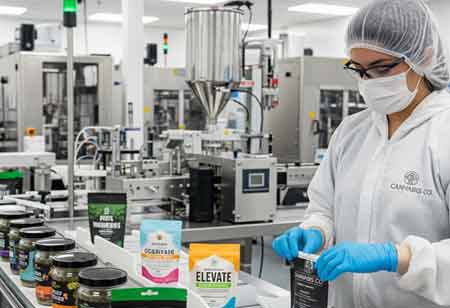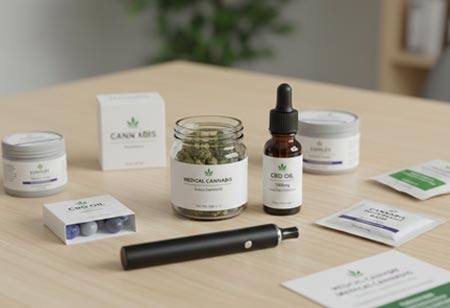Thank you for Subscribing to Cannabis Business Insights Weekly Brief
The Strategic Evolution of Cannabis Packaging
Cannabis packaging has evolved from a basic compliance requirement to a strategic branding element, emphasizing design, sustainability, technology, and adaptability in response to the complex regulations of an expanding market.

By
Cannabis Business Insights | Wednesday, September 24, 2025
Stay ahead of the industry with exclusive feature stories on the top companies, expert insights and the latest news delivered straight to your inbox. Subscribe today.
The evolution of cannabis packaging has transcended mere regulatory compliance, becoming a sophisticated and essential component of brand strategy. This transformation reflects the industry's own trajectory from obscurity to mainstream acceptance, where consumer perception and brand loyalty are of utmost importance. Presently, the unboxing experience holds comparable significance to the product itself, thereby converting a simple receptacle into an impactful communication instrument.
From Shelf Space to Brand Space
Early cannabis packaging was born from a place of caution and legal obligation. The primary concerns were child resistance, tamper-evidence, and adherence to stringent labeling requirements that varied significantly from one jurisdiction to another. The aesthetic was often sterile and medicinal, designed to appease regulators rather than attract consumers. The focus was squarely on what the packaging could not do: it could not appeal to minors, it could not make unsubstantiated health claims, and it could not deviate from prescribed informational mandates. This compliance-first approach, while necessary for legitimacy, resulted in a sea of homogenous and uninspired packaging that did little to differentiate one product from another.
As the market has matured and competition has intensified, brands now recognize that packaging is the first tangible interaction a consumer has with their product, offering a critical opportunity to convey quality, values, and a unique identity. This has given rise to a focus on design-driven packaging that is both compliant and compelling. Minimalism, for instance, has become a popular trend, characterized by clean lines, uncluttered typography, and a restrained color palette that conveys sophistication and purity. This approach not only stands out on crowded shelves but also subtly signals a premium product within.
Sustainability has become a key brand differentiator, with consumers increasingly favoring eco-friendly materials, including recycled plastics, biodegradable polymers, and glass. By investing in sustainable packaging, brands not only reduce their environmental footprint but also cultivate a positive brand image that resonates with a growing segment of the market. The message is clear: the care and consideration that go into the product extend to its impact on the planet.
The integration of technology is another frontier in the evolution of cannabis packaging. QR codes that link to detailed lab reports and product information build transparency and trust. Innovations in innovative packaging can also offer features like freshness indicators and authentication technologies, providing consumers with an enhanced level of confidence and engagement. This technological layer transforms the package from a static container into an interactive brand touchpoint.
The Maturation of Cannabis Packaging Services
In the early stages of legalization, many cannabis producers handled packaging in-house, often relying on manual labor for labeling and assembly. This artisanal approach, while functional for small operations, quickly became a bottleneck as demand grew. The need for efficiency, consistency, and strict quality control has driven the adoption of automated packaging solutions. Modern packaging facilities now utilize machinery for filling, sealing, labeling, and cartoning, which dramatically increases throughput and reduces the margin of human error. This industrialization allows brands to scale their operations effectively, ensuring that product availability keeps pace with market demand.
The materials used in cannabis packaging have also become more diverse and specialized. The choice between rigid and flexible packaging, for example, is now a strategic decision based on product type, branding, and cost considerations. Rigid containers, such as glass jars and metal tins, are often favored for premium flower and concentrates, as they offer superior protection and a high-end feel. Flexible packaging, including mylar bags and pouches, provides a lightweight, cost-effective, and highly customizable option for a wide range of products, from edibles to pre-rolls. The development of advanced barrier films and resealable closures has further enhanced the functionality of flexible packaging, ensuring product freshness and compliance with regulations.
Security and anti-counterfeiting measures have also become integral to industrial-grade packaging services. The illicit market remains a significant concern, and brands are investing in packaging features that protect their products and their reputation. Tamper-evident seals, holographic foils, and unique identifiers are now commonplace. These security elements not only deter counterfeiting but also provide consumers with visual cues that they are purchasing a legitimate and safe product. As the industry continues to professionalize, the demand for these sophisticated, secure packaging solutions will only intensify.
Navigating a Complex Regulatory Landscape
The global cannabis market is governed by fragmented and ever-changing regulations, making packaging a complex challenge for service providers. With rules differing not only between countries but also across states and provinces, navigating this lack of harmonization is a key strategic concern for those operating in multiple jurisdictions.
Packaging providers respond to regulatory diversity by offering modular, customizable systems that can be adapted to local requirements. This might involve creating packaging with designated areas for jurisdiction-specific labels or developing a range of compliant closure mechanisms that can be interchanged as needed. This flexible approach enables brands to maintain a consistent brand identity across various markets while still complying with local regulations.
The distinction between medical and recreational cannabis further complicates the regulatory picture. Medical cannabis packaging often has more stringent informational requirements, focusing on dosage, potency, and health warnings, akin to pharmaceutical products. Recreational cannabis packaging, while still heavily regulated, may have slightly more leeway in terms of branding and design, though restrictions on appealing to minors are universal. Packaging service providers must be adept at navigating these nuances to serve clients in both segments of the market.
Ultimately, achieving success within the global cannabis packaging industry necessitates a proactive and adaptable approach to regulatory compliance. Service providers that prioritize investment in regulatory intelligence and the development of versatile packaging solutions will be optimally positioned to assist their clientele in navigating the intricacies of the international market. As the industry progresses toward greater maturity, there is an escalating discourse concerning the potential for global standards, which could eventually streamline this complex regulatory framework. Nevertheless, for the present, the ability to master localized compliance remains a pivotal determinant of success.






